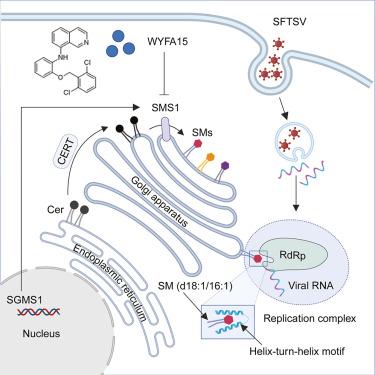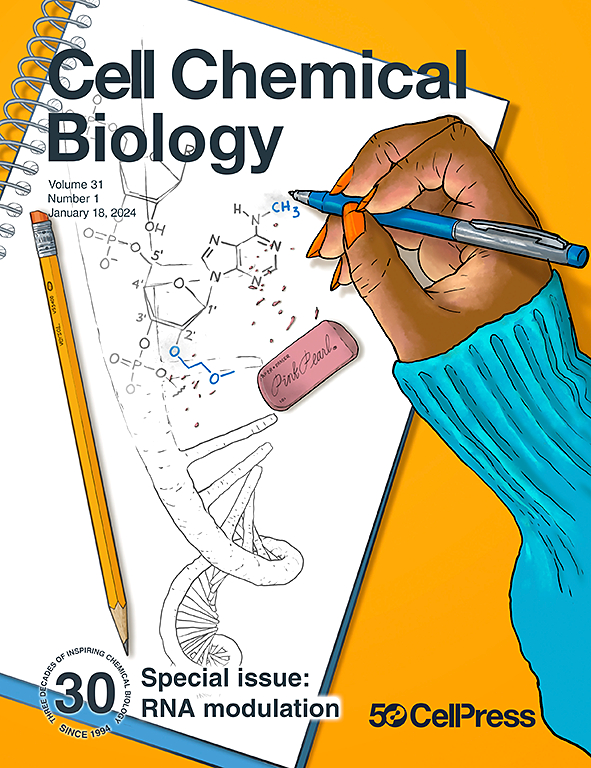Host specific sphingomyelin is critical for replication of diverse RNA viruses
IF 6.6
1区 生物学
Q1 BIOCHEMISTRY & MOLECULAR BIOLOGY
引用次数: 0
Abstract
Lipids and lipid metabolism play an important role in RNA virus replication, which typically occurs on host cell endomembrane structures in the cytoplasm through mechanisms that are not yet fully identified. We conducted genome-scale CRISPR screening and identified sphingomyelin synthase 1 (SMS1; encoded by SGMS1) as a critical host factor for infection by severe fever with thrombocytopenia syndrome virus (SFTSV). SGMS1 knockout reduced sphingomyelin (SM) (d18:1/16:1) levels, inhibiting SFTSV replication. A helix-turn-helix motif in SFTSV RNA-dependent RNA polymerase (RdRp) directly binds to SM(d18:1/16:1) in Golgi apparatus, which was also observed in SARS-CoV-2 and lymphocytic choriomeningitis virus (LCMV), both showing inhibited replication in SGMS1-KO cells. SM metabolic disturbance is associated with disease severity of viral infections. We designed a novel SMS1 inhibitor that protects mice against lethal SFTSV infection and reduce SARS-CoV-2 replication and pathogenesis. These findings highlight the critical role of SMS1 and SM(d18:1/16:1) in RNA virus replication, suggesting a broad-spectrum antiviral strategy.


宿主特异性鞘磷脂对多种 RNA 病毒的复制至关重要
脂质和脂质代谢在 RNA 病毒复制中发挥着重要作用,病毒复制通常是通过尚未完全确定的机制在细胞质中的宿主细胞内膜结构上进行的。我们进行了基因组规模的CRISPR筛选,发现鞘磷脂合成酶1(SMS1;由SGMS1编码)是感染严重发热伴血小板减少综合征病毒(SFTSV)的关键宿主因子。SGMS1 基因敲除会降低鞘磷脂(SM)(d18:1/16:1)的水平,从而抑制 SFTSV 的复制。SFTSV的RNA依赖性RNA聚合酶(RdRp)中的一个螺旋-转螺旋基团直接与高尔基体中的SM(d18:1/16:1)结合,在SARS-CoV-2和淋巴细胞性脉络膜炎病毒(LCMV)中也观察到了这种情况,这两种病毒在SGMS1-KO细胞中的复制都受到了抑制。SM代谢紊乱与病毒感染的疾病严重程度有关。我们设计了一种新型 SMS1 抑制剂,它能保护小鼠免受致命的 SFTSV 感染,并减少 SARS-CoV-2 的复制和致病机理。这些发现强调了 SMS1 和 SM(d18:1/16:1) 在 RNA 病毒复制中的关键作用,提出了一种广谱抗病毒策略。
本文章由计算机程序翻译,如有差异,请以英文原文为准。
求助全文
约1分钟内获得全文
求助全文
来源期刊

Cell Chemical Biology
Biochemistry, Genetics and Molecular Biology-Molecular Medicine
CiteScore
14.70
自引率
2.30%
发文量
143
期刊介绍:
Cell Chemical Biology, a Cell Press journal established in 1994 as Chemistry & Biology, focuses on publishing crucial advances in chemical biology research with broad appeal to our diverse community, spanning basic scientists to clinicians. Pioneering investigations at the chemistry-biology interface, the journal fosters collaboration between these disciplines. We encourage submissions providing significant conceptual advancements of broad interest across chemical, biological, clinical, and related fields. Particularly sought are articles utilizing chemical tools to perturb, visualize, and measure biological systems, offering unique insights into molecular mechanisms, disease biology, and therapeutics.
 求助内容:
求助内容: 应助结果提醒方式:
应助结果提醒方式:


